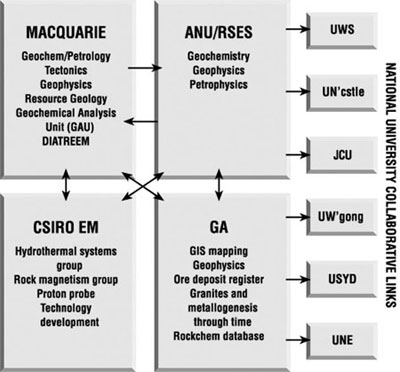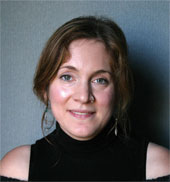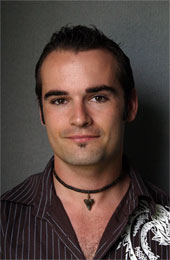GEMOC participants
THE HOST INSTITUTION for GEMOC is Macquarie University (in the Department of Earth and Planetary Sciences). There is close collaboration with state Geological Surveys, GA (Geoscience Australia), CSIRO, ANU/RSES and several major industry concerns, across an increasingly broad range of projects.
There is close collaboration with state Geological Surveys, GA (Geoscience Australia), CSIRO, ANU/RSES and several major industry concerns, across an increasingly broad range of projects.
Collaborative research, teaching and technology development links have been established with other universities nationally and internationally and these evolve as new alliances become relevant to new directions.
GEMOC has developed ongoing collaborative relationships with national and international industry and end-users such as Geological Surveys globally (eg some Australian states, Canada, Norway).
GEMOC has a wide network of international research and teaching development partners and collaborators.
A full list of GEMOC participants and their affiliations is given in Appendices 1 and 3
CHANGES IN 2005
 Professor Bernard Wood commenced as a Federation Fellow. The project ("Origin and evolution of the Earth’s chemical reservoirs") aims to understand the processes by which the Earth separated into its chemically distinct layers (core, mantle, crust, atmosphere, oceans) and to determine the nature of the continuing interactions between the surface environment in which we live and the deep interior. Experimental study of these processes involves establishment of a world-class facility for materials synthesis at high pressures and temperatures. This facility provides the means to simulate the processes occurring within the Earth and enables synthesis of new high-density materials of technological interest. This is only the second Federation Fellowship to be awarded in the Geosciences: the other one was to Professor Simon Turner, also in GEMOC in the Department of Earth and Planetary Sciences. Professor Wood has already established a world-class high-pressure experimental laboratory that includes a multi-anvil apparatus to generate pressures to 27 GPa.
Professor Bernard Wood commenced as a Federation Fellow. The project ("Origin and evolution of the Earth’s chemical reservoirs") aims to understand the processes by which the Earth separated into its chemically distinct layers (core, mantle, crust, atmosphere, oceans) and to determine the nature of the continuing interactions between the surface environment in which we live and the deep interior. Experimental study of these processes involves establishment of a world-class facility for materials synthesis at high pressures and temperatures. This facility provides the means to simulate the processes occurring within the Earth and enables synthesis of new high-density materials of technological interest. This is only the second Federation Fellowship to be awarded in the Geosciences: the other one was to Professor Simon Turner, also in GEMOC in the Department of Earth and Planetary Sciences. Professor Wood has already established a world-class high-pressure experimental laboratory that includes a multi-anvil apparatus to generate pressures to 27 GPa.

Dr Helen Williams commenced as the GEMOC-Nu Instruments Postdoctoral Fellow with funding from Nu Instruments to investigate isotopic systems relevant to the evolution and composition of the Earth, using both conventional and in situ analytical techniques. The initial project involved further development of the methodology for measuring iron isotopes followed by their application to unravelling mantle processes such as the evolution of oxygen in the mantle (and how this is linked to the development of the Earth’s atmosphere). This complements the Mg-isotopic studies on mantle rocks and provides a new tracer for mantle metasomatic processes and fluid sources.
Dr Sune Nielsen commenced a Postdoctoral Fellowship with funding from the Danish National Science Foundation and was subsequently awarded an ARC APD. His project addresses the recycling of crustal material back into the mantle at subduction zones. This is one of the most fundamental Earth processes, but its effect on the evolution of the geochemistry of the mantle, and the ultimate fate of the subducted material, are poorly understood. This project will use the stable isotope geochemistry of thallium as a novel and sensitive tracer to follow subducted oceanic crust through the subduction process, and test for its reappearance in hot-spot volcanoes and the continental lithosphere. This project will transfer to Australia an advanced new methodology: the characterisation of thallium isotopic signatures in the mantle system during recycling of crustal material. This will allow the tracking of fluid processes in the mantle system in a completely new way and will provide significant new information about the fluids that can percolate up from subduction zones.
 Dr Craig O’Neill was awarded a Macquarie University Research Fellowship for three years commencing 2006. His project will use quantitative numerical modelling to evaluate the links between episodes of intense mantle convection and the production of the continental crust that we live on. These models will assess the degree of melt production and crustal generation resulting from different styles of episodic mantle convection, and will determine which types of mantle evolution through time could produce the age distribution observed in the continental crust worldwide. The research addresses a critical shortcoming in our understanding of the formation and evolution of continents, with important implications for the distribution of major mineral and energy resources.
Dr Craig O’Neill was awarded a Macquarie University Research Fellowship for three years commencing 2006. His project will use quantitative numerical modelling to evaluate the links between episodes of intense mantle convection and the production of the continental crust that we live on. These models will assess the degree of melt production and crustal generation resulting from different styles of episodic mantle convection, and will determine which types of mantle evolution through time could produce the age distribution observed in the continental crust worldwide. The research addresses a critical shortcoming in our understanding of the formation and evolution of continents, with important implications for the distribution of major mineral and energy resources.

 GEMOC ARC National Key Centre
GEMOC ARC National Key Centre